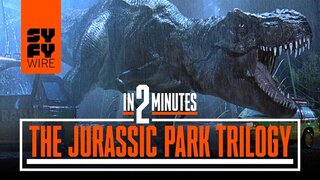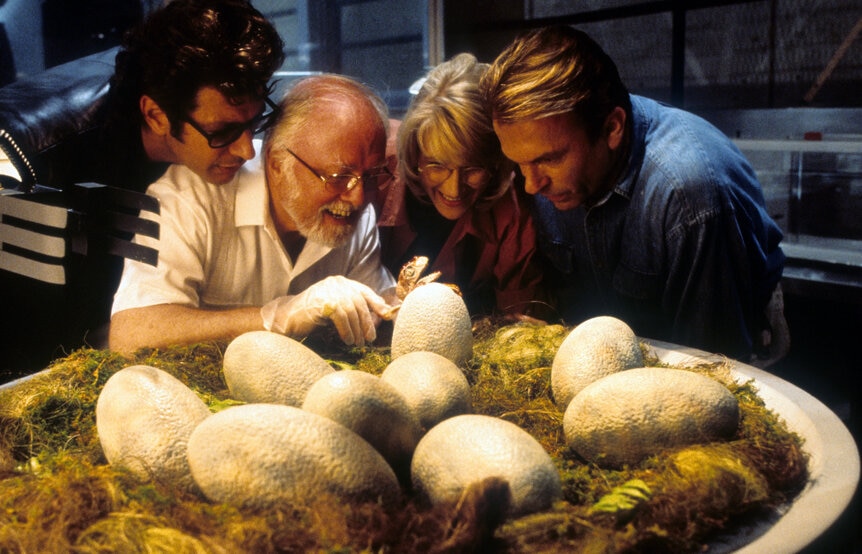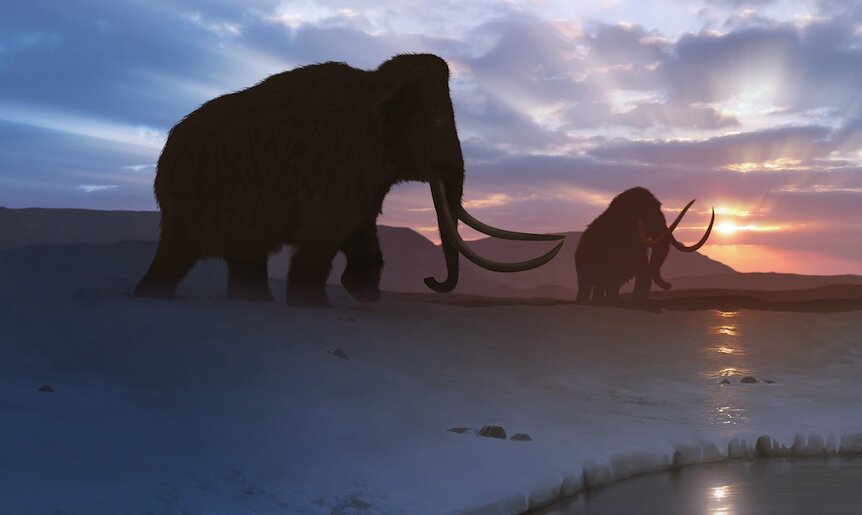Create a free profile to get unlimited access to exclusive videos, sweepstakes, and more!
How Close Are We to Cloned Dinosaurs? The Science Behind Jurassic Park
Closer, but the road is long.
Jurassic Park, the masterpiece of horror science fiction from Steven Spielberg and Michael Crichton, just celebrated its 30th birthday and it’s time for us to revisit the grand dream and overwhelming hubris of one John Hammond. When we're done looking into the science behind Jurassic Park's fiction here, you can revisit that dream yourself with the original film, streaming now on Peacock!
Can we clone dinosaurs, like in Jurassic Park?
Short answer: Not yet... but we're getting closer!
Spared No Expense
Say what you want about Hammond, but the man had vision, moxie, and a willingness to see things through, no matter the cost. To bring his park to fruition, scientists had to complete a complicated multistep process starting in the dirt and ending with a freshly hatched prehistoric monster. First, they needed to recover viable DNA from a preserved sample. In the movie, they achieve that by retrieving DNA from ancient mosquitos preserved in amber. At least, that’s what we’re told.
RELATED: "Whit Hertford, Jurassic Park's '6-Foot Turkey' Kid, Looks Back on Iconic Role 30 Years Later"
Getting the genes is only the first step. Scientists then need a way to get that DNA into a living cell and implanted in a surrogate animal for incubation. Unless they have magical incubation machines which can organize DNA and build an animal from scratch, that’s the only way we know of to make living genetic copies. That’s no small feat today, let alone in 1993. Thirty years after the release of Jurassic Park, we’re getting closer to realizing Hammond’s dream, but how close are we really?
Hunting for Buried Genetic Treasure
If we want to build our very own Jurassic Park, we’re first going to need some dino DNA. Getting viable genetic material from a living thing is easy, all things considered. A cotton swab in the cheek or a hair sample is all it takes to get the genetic recipe you’re looking for. Sequencing that DNA will take a little time, but even that is getting faster and more affordable.
Getting ahold of DNA from extinct animals isn’t unheard of, but it isn’t necessarily easy. There are programs all over the world working to build genetic catalogues of living animals for scientists to pull from, in the event that species disappears. For species which went extinct recently, stored genetic samples may already exist. Even if not, we can usually get at least portions of a sequence from preserved animals or parts of animals, like museum specimens or pelts. In some cases, like the woolly mammoth, animals preserve themselves, making their DNA available to use thousands of years after their disappearance. Longer than that and you run into a barrier.
If you can get your hands on a body that still has fur or soft tissue, you’ve got a pretty good shot at a DNA sample, but there is a limit. Research into the decay rate of DNA finds that it can last quite a while under the right conditions. DNA preserved in permafrost can stay fresh for a few hundred thousand years but that’s creeping up on a hard stop. Scientists estimate that the final best by date for DNA is about a million years after an organism’s death, and that’s only under the exact right conditions. We’re about 65 million years too late for retrieving viable dinosaur DNA.
The Cloning Process
Assuming we could get hold of workable dinosaur ingredients, we'd still need to cook it. While cloning is still largely the stuff of science fiction, we’ve actually got a pretty good handle on the science of it. Dolly the sheep made headlines way back in 1996, only three years after Jurassic Park hit theaters, when she became the first successfully cloned mammal.
To date, more than 20 species have been cloned, with 19 of them surviving into adulthood. The list of cloned animals includes a camel named Injaz, a brown rat named Ralph, a black-footed ferret named Elizabeth Ann, a deer named Dewey, eight coyotes, horses, mice, monkeys, pigs, rabbits, fruit flies, amphibians, and several domestic cattle with names like Gene (haha), Daisy, and Second Chance (cloned from a bull named Chance).
RELATED: Back From The Dead? Cloned Ferret Offers Hope For Endangered Species
For the most part, cloning is achieved through a process known as somatic cell nuclear transfer (SCNT). The technique involves removing the nucleus of an egg cell and replacing it with a somatic (body) cell from the animal you want to clone. For that to work, you need access to two things: a somatic cell from your target species, and oocytes (egg cells) from that same species or one closely related enough to serve as a surrogate.
That’s relatively easy to do with mammals but becomes more complicated with egg-laying species like reptiles and birds. Dinosaurs, of course, exist pretty squarely in dino/bird territory, so it’s likely we’d run into the same challenges cloning them, even if we had good DNA. Before we get there, we’ve got some significant technological and scientific hurdles to overcome.
The State of Real World De-Extinction
Not to be dissuaded, several laboratories and commercial entities around the world are advancing the field of animal cloning in truly exciting ways. Perhaps the most well-known is Colossal Biosciences, billed as the world’s first de-extinction company.
Extinction is an ordinary part of nature’s life-cycling process, but there’s no question that humanity accelerated the path toward oblivion for more than a few species. Colossal’s mission, in essence, is to undo some of the damage our species has done and allow certain key species another chance to fill their niche.
The company has announced a project to resurrect or de-extinct three species. The first, and perhaps most charismatic, is the woolly mammoth. While they died out several thousand years ago, some of them had the good sense to die in very cold, very dry places, where their bodies have been preserved for thousands of years. Using their living relatives, the elephants, scientists hope to return mammoths to the Arctic.
Colossal is also working on resurrecting the thylacine, more commonly known as the Tasmanian Tiger. It went extinct in 1936 and researchers have access to a few well-preserved specimens. Their closest living relative is a diminutive little guy with an insulting name: the fat-tailed dunnart. The goal is to use them as surrogates for the first cloned thylacines.
Most recently, Colossal announced their dodo de-extinction project, marking the company’s first bird project. The dodo vanished circa 1,600 and is closely related to some species of living pigeon. Researchers at Colossal are working to solve some of the challenges related to bird cloning and expect to have living animals sometime in the next several years.
It’s possible, though unlikely, that some of the breakthroughs achieved during the dodo project could facilitate some dinosaur cloning down the line. But we wouldn’t bet on it.
If you want to see dinosaurs, your best bet is at the movies. Catch Jurassic Park, streaming now on Peacock.

































